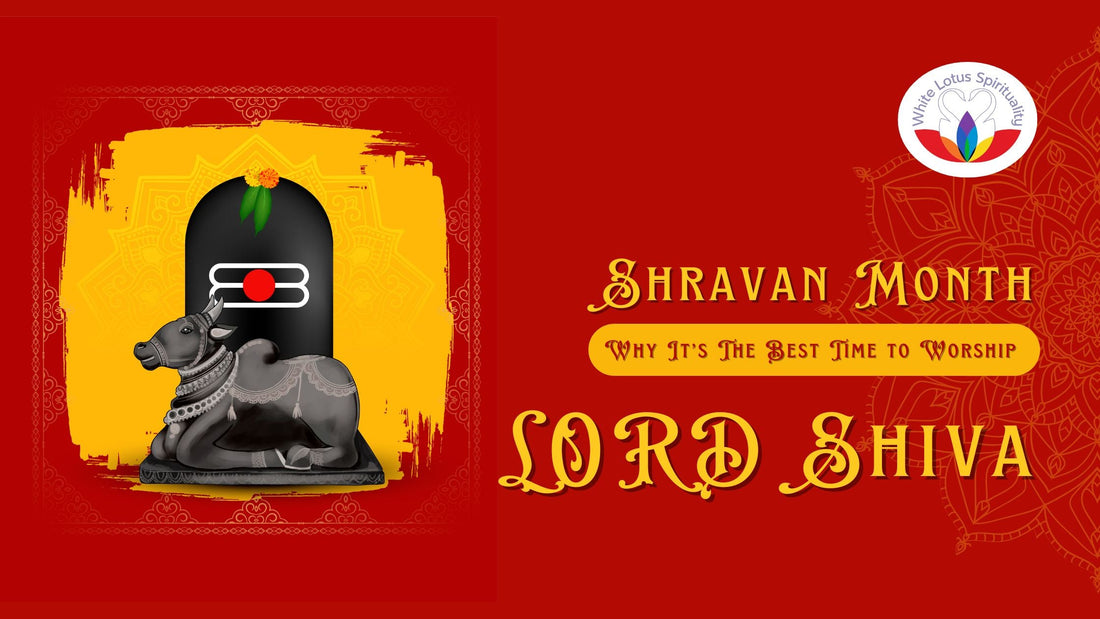
Shravan Month: Why It’s The Best Time to Worship Lord Shiva
Share
The Shravan, or Sawan, month is near and dear to the hearts of every Hindu devotee everywhere in India and across the globe. Occurring in the fifth month of the Hindu calendar, typically July and August, the sacred month is considered the most auspicious period for worshipping Lord Shiva. Devotees greet the month with devotion, fasting, travels, and prayers with the sole aim of making the great Mahadev happy.
But why is Shravan so special for offering devotion to Lord Shiva? Why is it even more special than any one of the twelve months of the Hindu calendar? Let us attempt to understand the spiritual, mythological, and astronomical reasons behind the profound reverence for Lord Shiva during this sacred period.
What is the Shravan Month?
Shravan, so-called after the star "Shravana Nakshatra," is a period when the moon stays close to this star, and most planetary positions are conducive to spiritual endeavors. Monsoon rains bring life and rejuvenation to the Indian subcontinent only in this month, offering a real picture of the spiritual rejuvenation that believers aspire to.
Monday (Somwar) in Vedic astrology is governed by the Moon, which is highly associated with the mind and emotions. As Lord Shiva has been referred to as Somnath (the Lord of the Moon), Mondays during the Shravan month are particularly effective for spiritual bonds and inner cleansing.
Mythological Significance of Shravan and Lord Shiva
The significance of Shravan in the process of worshipping Shiva lies in its connection to one of the most potent myths in Hindu mythology: the Samudra Manthan, or the churning of the ocean.
In this cosmic occurrence, a relentless poison known asHalahala arose from the ocean and was about to wipe out everything that breathed. Lord Shiva, as an act of sacrifice, swallowed the poison to preserve the universe as he had poison in his throat (his throat became blue and hence he is also called Neelkanth), the gods and his devotees showered water from sacred rivers to calm him down. This showering of water and other holy offerings became the basis for shraddha rituals done during Shravan.
Therefore, whenever a devotee performs Jalabhishek (a holy water offering) or a Rudrabhishek (a ritual performed through Vedic mantras), it is said to appease and mollify Lord Shiva, thereby increasing the ritual's significance further during Shravan.
Also Read:- Importance of Rudraksha on Mahashivratri
Rituals and Devotion of Shravan Month
The devotees undergo severe and strict practices and systematic routines during Shravan. Some of the most prominent rituals include:
1. Shravan Somwar Vrat (Monday Fasts)
Devotees keep fasts on each Monday of the Shravan month. Women keep fasts to obtain a good husband, and men observe fasts for courage, intelligence, and divine strength.
2. Jalabhishek and Rudrabhishek
Devotees bathe the Shiva Linga with water, milk, curd, honey, ghee, and Bilva leaves (Bel Patra), reciting sacred mantras such as "Om Namah Shivaya" and the Maha Mrityunjaya Mantra.
3. Kanwar Yatra
In northern India, specifically in Uttar Pradesh, Bihar, and Uttarakhand, Shiva devotees, also known as Kanwariyas, fetch water from the Ganga River and trek barefoot to present it to Shiva temples, particularly to the Jyotirlingas.
Also Read:- The History and Significance of Rudraksha in Hinduism and Buddhism
Why Shravan is the Most Auspicious for Shiva Worship
- Spiritual Energy at its Pinnacle: Shravan's planetary position makes the practice of spirituality easy as it helps pilgrims to focus, meditate, and communicate with God more easily.
- Shiva Most Accessible: Lord Shiva is described to be "Ashutosh", easily accessible, as per the scriptures. In the month of Shravan, he is also reportedly more inclined to listen to prayers and engage in penance.
- Symbol of Transformation: Just as rain rejuvenates the world, the Shravan rituals seek to cleanse the mind and spirit.
- Karmic Purification: Fasting, prayer, and worship in this month are described to incinerate ill karma, remove obstacles, and bring peace and prosperity.
Celebrations in India
The month of Shravan is celebrated with great enthusiasm throughout India. Some of the popular temples where grand celebrations are seen include:
- Kashi Vishwanath Temple (Varanasi)
- Kedarnath (Uttarakhand)
- Somnath (Gujarat)
- Mahakaleshwar (Ujjain)
- Baidyanath Dham (Jharkhand)
The devotees walk miles or stand in queues for hours to provide water and receive blessings from Lord Shiva.
Also Read:- How to Wear Rudraksha - Rules of Wearing Rudraksha
Tips for Devotees
- Wake up early and bathe before sunrise.
- Chant Shiva mantras and recite the Shiv Puran.
- Avoid consuming tamasic foods, such as onions, garlic, and meat.
- Wear Rudraksha beads and go to temples regularly.
- Help others, give alms, or feed cows as an act of karma yoga.
Conclusion
The Shravan month is not merely a ritual; it is a reawakening to the divine, a feeling of blissful selflessness, and an opportunity to spend time in spiritual uplift. Lord Shiva's worship during this sacred time is believed to bring about a lotus-like tranquillity, melt away concerns, and bestow divine grace.
As monsoon rains sweep the world, let this Shravan purify your mind and soul. Leave your worship to Mahadev, and observe how he transforms your life with grace, vigour, and peace.
